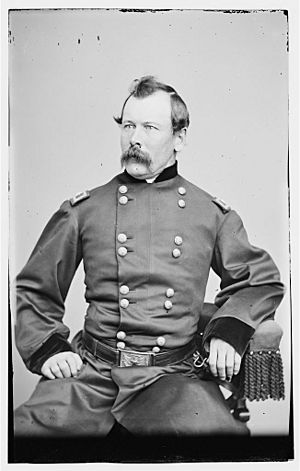Thomas Devin facts for kids
Quick facts for kids
Thomas Casimer Devin
|
|
|---|---|

Gen. T.C. Devin
|
|
| Nickname(s) | Buford's Hard Hitter |
| Born | December 10, 1822 New York City, New York |
| Died | April 4, 1878 (aged 55) New York City, New York |
| Place of burial |
West Point Cemetery
|
| Allegiance | United States of America Union |
| Service/ |
United States Army Union Army |
| Years of service | 1861–1878 |
| Rank | |
| Commands held | 6th New York Cavalry 2nd Bde, 1st Div, Cav Corps 1st Division, Cavalry Corps 3rd U.S. Cavalry |
| Battles/wars | American Civil War Indian Wars |
Thomas Casimer Devin (born December 10, 1822 – died April 4, 1878) was a brave officer and general in the United States Army. He led Union cavalry (soldiers on horseback) during the American Civil War and later in the Indian Wars.
Contents
Early Life and Beginnings
Thomas Casimer Devin was born in New York City. His parents were from Ireland. Before he became a soldier, Devin worked as a house painter. He even owned a paint and varnish company with his brother, John. At the same time, he was also a lieutenant colonel in the New York State Militia, which was like a local army group.
Serving in the Civil War
When the Civil War began, Devin quickly turned his militia cavalry group into "Captain Devin's Independent Company." He became its captain. Later that year, he was promoted to Colonel of the 6th New York Volunteer Cavalry. This group was also known as the "2nd Ira Harris Guards." He led them for about a year.
Early Battles and Leadership
The 6th New York Cavalry first saw important action in the Maryland Campaign of 1862. At the Battle of Antietam, some of his soldiers were part of the first attacks of the day.
At the Battle of Fredericksburg, Devin took over command of a cavalry brigade (a large group of soldiers). This happened when the previous commander, George Dashiell Bayard, was sadly killed by enemy artillery.
Chancellorsville and Beyond
In 1863, at the Battle of Chancellorsville, Devin's small brigade was the only cavalry unit that stayed with the main army. All other cavalry had gone on a special mission. Devin successfully led three Union Corps (very large army units) on a secret march around the enemy, which happened before the main battle. His soldiers fought very bravely and suffered many losses, almost 200 casualties. This was a high number for cavalry at that time.
Devin also led his brigade at the Battle of Brandy Station in June 1863. During this battle, his horse was shot from under him while he was checking on the front lines. He then took command of a division (an even larger group) under Brig. Gen. John Buford.
Gettysburg: A Key Role
At the famous Battle of Gettysburg, Devin's brigade was part of Brig. Gen. John Buford's cavalry division. They were crucial on the first day of the battle, July 1, 1863. Devin was a favorite of Buford's because of his tough leadership style. He even earned the nickname "Buford's Hard Hitter." His own soldiers liked to call him "Uncle Tommy."
Devin's brigade was positioned to guard the northwest and northern roads leading into Gettysburg. They successfully slowed down the arrival of Confederate General Jubal A. Early's division. This delay was very important for the Union army. Later, some of his brigade had to pull back into the town due to accidental fire from their own Union artillery. They continued to fight the Confederates as they entered the town.
Later War Service
After Gettysburg, Devin continued to lead brigades and sometimes divisions in the main Union cavalry force. In the spring of 1864, he took part in a raid on Richmond, the Confederate capital. In August, he and his cavalry joined Maj. Gen. Philip Sheridan in the Shenandoah Valley Campaigns of 1864.
Devin was wounded once during the war. He was shot in the foot on August 16, 1864, during fighting in Virginia. When his commander, Wesley Merritt, was promoted, Devin took over command of his division. On November 19, 1864, President Abraham Lincoln made Devin a brigadier general of volunteers for his bravery at the Battle of Cedar Creek.
After the Civil War
After the Civil War ended, Thomas Devin continued his military career in the Regular Army. He became a Lieutenant Colonel and was assigned to the 8th U.S. Cavalry. He served in places like New Mexico and Arizona.
Devin later became a Colonel of the 3rd U.S. Cavalry. He sadly died on April 4, 1878, from stomach cancer and exposure, while on sick leave. He was first buried in Calvary Cemetery, but later, in 1897, he and his wife were reburied together at West Point Cemetery in New York. This was very close to his old friend and commander, John Buford.
Remembering Thomas Devin
To honor Thomas Devin, the United States Army set up a temporary camp in Montana Territory on June 30, 1878. It was named "Camp Devin." This camp was used by soldiers building a telegraph line until it was no longer needed later that year.

